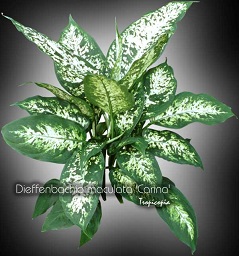Table of contents
Dumcane

Latin Name: Dieffenbachia maculata ‘Carina’
Category: Dieffenbachia
Family: Araceae
Origin: Hybrid
Climate: Tropical
Growing Zones: 11-10
Care Instructions
The Dumcane (Dieffenbachia maculata ‘Carina’) is a tropical plant that originates from Hybrid. This dieffenbachia plant belongs to the Araceae family and is well-suited for growing in USDA zones 11-10.
Complete Care Guide for Dumcane (Dieffenbachia maculata ‘Carina’)
Watering Requirements
The Dumcane, or Dieffenbachia maculata ‘Carina’, thrives best with a consistent watering schedule. It is essential to keep the soil evenly moist but not soggy. Water the plant when the top inch of the soil feels dry to the touch. During the growing season, typically spring and summer, you may need to water more frequently, about once a week. In the fall and winter months, reduce watering to every two weeks, as the plant’s growth slows down. Overwatering can lead to root rot, so ensure that the pot has good drainage and that excess water can escape. Always use room temperature water to avoid shocking the plant.
Light Conditions
Dumcane prefers bright, indirect light but can tolerate lower light conditions. Direct sunlight can scorch its leaves, leading to brown tips and edges. Ideally, place your Dumcane near a window with filtered light or in a well-lit room where it can receive bright, indirect sunlight for several hours a day. If the plant is not receiving enough light, you may notice slower growth and a leggy appearance. Conversely, if the leaves start to yellow or develop brown spots, it may be receiving too much direct sunlight. Rotate the plant occasionally to ensure even growth and exposure to light.
Soil Preferences
The ideal soil for Dumcane is a well-draining potting mix that retains some moisture without becoming waterlogged. A mix of peat moss, perlite, and pine bark works well, providing the necessary aeration and drainage. You can also use a commercial potting soil designed for houseplants, but ensure it has good drainage properties. Fertilization is important during the growing season; use a balanced, water-soluble fertilizer every 4-6 weeks to promote healthy growth. In the fall and winter, reduce fertilization as the plant enters a dormant phase. Always check the soil moisture before fertilizing to avoid stressing the plant.
Pests and Diseases
Dumcane is generally resilient but can be susceptible to common houseplant pests such as spider mites, aphids, and mealybugs. Regularly inspect the undersides of leaves and stems for signs of infestation. If you notice pests, treat them promptly with insecticidal soap or neem oil, ensuring to cover all affected areas. Additionally, watch for signs of fungal diseases, which can occur if the plant is overwatered or in overly humid conditions. Yellowing leaves, wilting, or a mushy stem can indicate root rot. To prevent this, ensure proper watering practices and good air circulation around the plant.
Special Care Tips
To keep your Dumcane healthy and thriving, consider the following special care tips: First, regularly wipe the leaves with a damp cloth to remove dust, which can hinder photosynthesis. This also allows you to check for pests more easily. Second, maintain a humidity level of around 50-60% for optimal growth; you can achieve this by misting the leaves or placing a humidifier nearby. If the air is too dry, the leaf tips may turn brown. Lastly, be cautious with pets and children, as the sap of the Dumcane is toxic if ingested. Always wash your hands after handling the plant to avoid any irritation. With these care tips, your Dumcane will flourish and add a vibrant touch to your indoor space.








